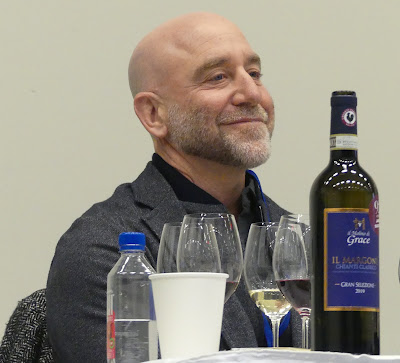Photo: Daniel Grace, the Tuscan vintner from California
Among the 71 Italian wineries at the recent Vancouver International Wine Festival, perhaps the most unexpected discovery was a producer from Tuscany called Il Molino di Grace. Daniel Grace and his family, who launched the winery venture in 1995, originally came from California.
Frank Grace, Daniel’s father, formerly operated a shipping business based in Britain. Wine lovers and wine collectors, the Grace family were intimately familiar with the Chianti region in Tuscany. When the opportunity arose to buy a 350-year-old 20-hectare Tuscan vineyard, “we leaped at it,” Daniel told me in an interview.
The state-of-the-art winery, which was built in 1997, is named after a 19th century historic windmill on the property. Molino is Italian for windmill.
One of the first moves by the Grace family was to pull out the Cabernet Sauvignon vines and replacing them with indigenous Tuscan varietals such as Canaiolo and Colorino. The Grace family was at the forefront of the movement away from blending French varietals into so-called Super Tuscan wines. While the Super Tuscan wines were delicious, many Tuscan (and other Italian) producers have rediscovered the purity of wines made with the native Italian varietals.
There are at least 600 indigenous Italian varietals. Many were on the cusp of extinction in the 1980s before Italy recognized that the world did not need another Chardonnay or Merlot.
“When we first set foot on the property,” Daniel says, “there was a sense of, oh my God, here come Californians. We will Napa-fi Tuscany. I think Napa is sort of Disneyland. If anything, we fell in love with this majestic purity [in Tuscany]. All of our Chianti has always been 100% Sangiovese. Our Super Tuscan is all made with indigenous fruit. We made significant changes to the vineyards. When we first arrived, we ripped out all the Cabernet, so we would not be tempted to scratch that itch. We went into it acutely aware of tradition and authenticity. I think it has been our compass.”
The rise in the quality of Chianti in recent decades has been dramatic. “The Chianti Classico region hasn’t had such a sexy swagger since the days of the Medicis,” Daniel says. “Ten, 15 years ago, I would walk into a room and say, sheepishly, let me change your mind about what you think about Chianti Classico wines. Now, I see it in people’s eyebrows --- that eyebrow-raising expectation one glass at a time. It is such a pleasure to see the response in the market place.”
He gives a lot of credit to the Gran Selezione designation established in the Chianti Classico region a decade or so ago. It is the tide that “lifts all ships,” he says.
“With the inaugural crop of the Gran Seleziones in the 2010 vintage, we were one of 19 producers,” Daniel continues. “And ours was the only 100% Sangiovese.”
The Chianti Riserva region encompasses the premium terroir of the larger Chianti producing area in Tuscany. The wines from the Riserva producers are divided into several quality classifications, starting with Chianti Classico, followed by Chianti Classico Riserva and then by Chianti Classico Riserva Gran Selezione. Regulations define the production methods that influence the quality of each wine designation.
The requirements for Gran Selezione became official in 2014. They specify that the grapes must be from the producer’s estate; that the wines must be a minimum of 80% Sangiovese; and that the wines must be aged a minimum of 30 months (compared with 24 months for Riserva and about a year for Classico).
“The requirement is 90% Sangiovese but I love to push it to 100% Sangiovese for Gran Seleziones,” Daniel says. (The current requirement is 80% Sangiovese, rising to 90% with the 2027 vintage.)
The winery has been certified organic since 2010. “Since its inception, Il Molino di Grace has made every effort to be a sustainable, bio-dynamic winery,” the website says. “We plow each vineyard only once every three years to the most shallow depths between the rows (maximum of 45 cm.) We use the cuttings from the vines to fuel the heating and air conditioning in the winery, thus eliminating the use of gas. All of the fertilizer used in the vineyards is organic, the yeast is indigenous, and the grapes are harvested and picked by hand only. Farming sustainably is a critical part of everything we do.”
Here are the four Chianti wines that Daniel Grace poured at the Wine Festival. His Vancouver agent, Patagonia Imports, has the wines in the Vancouver market.
Gratius Toscano IGT 2018 ($97.99). This is a powerful Super Tuscan incorporating only indigenous varietals (Sangiovese, Canaiolo, Colorino), proving that one need not have French varietals in the blend to make a great wine. This wine will age very well. 95.
Il Margone Chianti Classico Gran Selezione 2018 ($57.99). This wine is made entirely with estate-grown Sangiovese. The wine is full-bodied with aromas and flavours of cherry, blackberry, black currant and spice, with a spine of minerality and long ripe tannins. 93.
Chianti Classico Riserva 2020 ($51.99). This wine has a lovely core of fruit, an almost unexpected richness for a Sangiovese wine. That is complimented by notes of cherry and spice, with a long finish. 92.
Chianti Classico 2020 ($38.99). The style of this wine, which is 100% Sangiovese, is brighter and leaner, with flavours of red fruit and with firm tannins. 90.
Trending Articles
More Pages to Explore .....

































